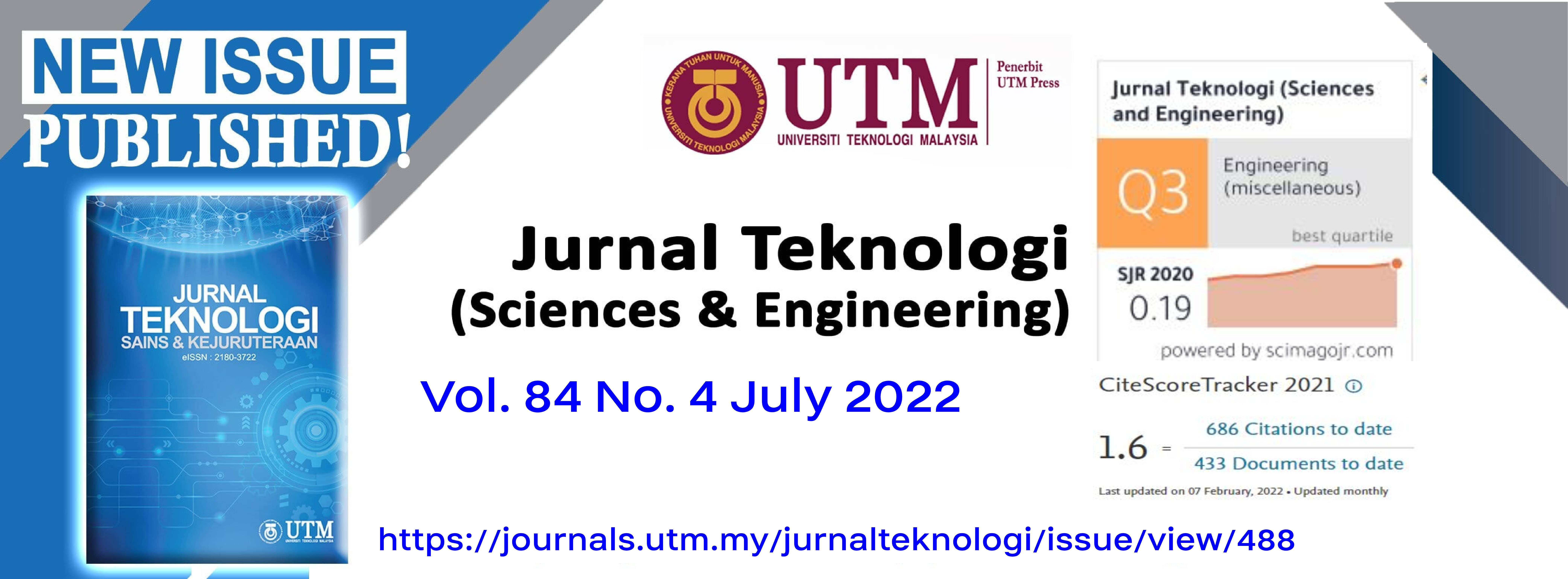INTERACTIONS BETWEEN TIDAL TURBINE WAKES: NUMERICAL STUDY FOR SHALLOW WATER APPLICATION
DOI:
https://doi.org/10.11113/jurnalteknologi.v84.17731Keywords:
Tidal array, Staggered array, Marine energy, Turbulent mixing, Wake recoveryAbstract
The placement of tidal turbines in a tidal farm is challenging owing to the flow resistance caused by individual devices. To successfully deploy tidal turbines, the wake interaction between devices, often determined by the array's layout and spacing, must be understood. In this study, the impact of array configuration for shallow water application is examined numerically using computational fluid dynamics (CFD). This is to propose a suitable array structure for possible implementation in Malaysia. This numerical study uses 15 turbines in a staggered and squared array with two sets of lateral and longitudinal spacing combinations. The horizontal axis tidal turbine (HATT) and vertical axis tidal turbine (VATT) are represented using disc and cylindrical models, respectively. The VATT with staggered setup and greater spacing model demonstrates faster wake recovery (between 10% to 21%), compared to the squared arrangement. This meets the far wake criteria and reduces the chance of wake mixing. It is also suitable for shallow depth implementation.
References
D. Satrio, I. K. A. P. Utama, and Mukhtasor. 2016. Vertical Axis Tidal Current Turbine: Advantages and Challenges Review. Proceeding Ocean. Mech. Aerosp. -Science Eng. 3(July): 64-71. [Online]. Available: http://isomase.org/OMAse/Vol.3-2016/Section-1/3-7.pdf.
F. Mushtaq, W. Maqbool, R. Mat, and F. N. Ani. 2013. Fossil Fuel Energy Scenario in Malaysia-prospect of Indigenous Renewable Biomass and Coal Resources. Doi: 10.1109/CEAT.2013.6775632.
N. Gomesh, I. Daut, M. Irwanto, Y. M. Irwan, and M. Fitra. 2013. Study on Malaysian's Perspective Towards Renewable Energy Mainly on Solar Energy. Energy Procedia. 36: 303-312.
K. S. Lee and L. Y. Seng. 2009. Simulation Studies on the Electrical Power Potential Harnessed by Tidal Current Turbines. J. Energy Environ. 1: 18-23.
I. K. A. P. U. E. Septyaningrum, R. Hantoro and N. A. S. J. Prananda, G. Nugroho, A. W. Mahmashani. 2017. Performance Analysis of Multi-row Vertical Axis Hydrokinetic Turbine–straight Blade Cascaded (VAHT-SBC) Turbines Array. J. Chem. Inf. Model. 110(9): 1689-1699. Doi: https://doi.org/10.15282/jmes.13.3.2019.28.0454.
H. Y. Chong and W. H. Lam. 2013. Ocean Renewable Energy in Malaysia: The Potential of the Straits of Malacca. Renewable and Sustainable Energy Reviews. 23: 169-178. Doi: 10.1016/j.rser.2013.02.021.
F. Behrouzi, M. Nakisa, A. Maimun, and Y. M. Ahmed. 2016. Renewable Energy Potential in Malaysia: Hydrokinetic River/Marine Technology. Renewable and Sustainable Energy Reviews. 62: 1270-1281. Doi:10.1016/j.rser.2016.05.020
A. Roberts, B. Thomas, P. Sewell, Z. Khan, S. Balmain, and J. Gillman. 2016. Current Tidal Power Technologies and Their Suitability for Applications in Coastal and Marine Areas. J. Ocean Eng. Mar. Energy. 2198-6452. Doi: 10.1007/s40722-016-0044-8.
M. De Dominicis, R. O’Hara Murray, and J. Wolf. 2017. Multi-scale Ocean Response to a Large Tidal Stream Turbine Array. Renewable Energy. 114(Part B): 1160-1179.
P. Ouro, L. Ramírez, and M. Harrold. 2019. Analysis of Array Spacing on Tidal Stream Turbine Farm Performance using Large-Eddy Simulation. Journal of Fluids and Structures. 91: 102732.
D. Mehta, A. H. van Zuijlen, B. Koren, J. G. Holierhoek, and H. Bijl. 2014. Large Eddy Simulation of Wind Farm Aerodynamics: A Review. Journal of Wind Engineering and Industrial Aerodynamics. 133: 1-17.
F. Attene, F. Balduzzi, A. Bianchini, and M. Sergio Campobasso. 2020. Using Experimentally Validated Navier-stokes CFD to Minimize Tidal Stream Turbine Power Losses Due to Wake/Turbine Interactions, Sustain. 12(21): 2-26. Doi: 10.3390/su12218768.
E. W. Purnomo and D. P. Ghosh. 2018. Identifying Shallow Water Flow in Offshore Malaysia using Multicomponent Data and FWI Approach. Paper presented at the Offshore Technology Conference Asia, Kuala Lumpur, Malaysia, March 2018. Doi: https://doi.org/10.4043/28276-MS
P. Ouro, M. Harrold, T. Stoesser, and P. Bromley. 2017. Hydrodynamic Loadings on a Horizontal Axis Tidal Turbine Prototype. Journal of Fluids and Structures. 71: 78-95.
D. Fallon, M. Hartnett, A. Olbert, and S. Nash. 2014. The Effects of Array Configuration on the Hydro-environmental Impacts of Tidal Turbines. Renew. Energy. 64: 10-25. Doi: 10.1016/j.renene.2013.10.035.
C. D. Scott-Pomerantz. 2004. The K-Epsilon Model in Theory of Turbulence. University of Pittsburgh, Pittsburgh.
D. Kuzmin, O. Mierka, and S. Turek. 2007. On the Implementation of the fr-fturbulence Model in Incompressible Flow Solvers based on a Finite Element Discretisation. Int. J. Comput. Sci. Math.1(2-4): 193-206. Doi: 10.1504/ijcsm.2007.016531.
B. Johnson, J. Francis, J. Howe, and J. Whitty. 2014 Computational Actuator Disc Models for Wind and Tidal Applications. Journal of Renewable Energy. Doi: 10.1155/2014/172461.
B. C. Hoe. 2019. The Influence of Tidal Turbine In Array Configuration on the Wake Formation For Shallow Water. Universiti Malaysia Perlis,
M. E. Harrison, W. M. J. Batten, L. E. Myers, and A. S. Bahaj. 2010. Comparison between CFD Simulations and Experiments for Predicting the Far Wake of Horizontal Axis Tidal Turbines. IET Renew. Power Gener. 4(6): 613-627. Doi: 10.1049/iet-rpg.2009.0193.
A. Bakri. 2020. Numerical Assessment of Vertical Axis Marine Current Turbines Performances in Shallow Water : A Case Study for Malaysia. Universiti Malaysia Perlis (UniMAP).
Downloads
Published
Issue
Section
License
Copyright of articles that appear in Jurnal Teknologi belongs exclusively to Penerbit Universiti Teknologi Malaysia (Penerbit UTM Press). This copyright covers the rights to reproduce the article, including reprints, electronic reproductions, or any other reproductions of similar nature.
















